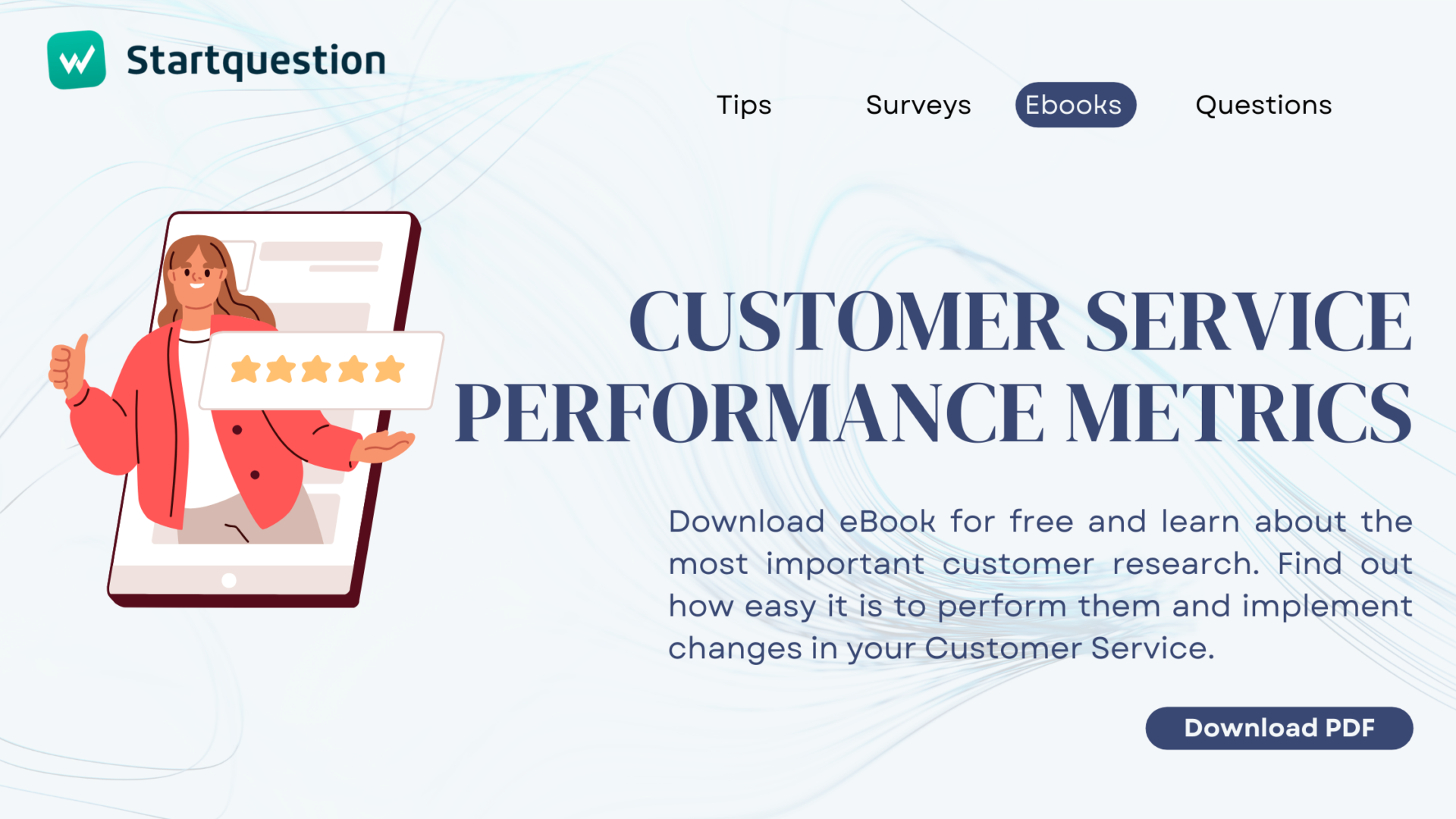Where to get knowledge about how much effort has the customer put into a given process? Use online surveys! Lots of practical information about the customer experience in contact with a company will help you get a Customer Effort Score survey. For several years, the CES indicator, along with the Net Promoter Score, has been considered a key element in research by departments and experts in Customer Experience.
We have already mentioned the Net Promoter Score many times on our blog, which allows to measure the level of consumer loyalty. However, NPS is just one type of customer research chosen by the world’s largest companies. In fact, most customers only want a simple, quick solution to their problem. Exceeding customer expectations has a negligible impact on their loyalty. Instead of delivering amazing Customer Experience and inventing extraordinary solutions, companies just have to… reduce customer effort.
Customer Effort Score Questions Examples
What is the Customer Effort Score (CES), or what exactly does the study involve? The best answer to this question will be… a question. The key Customer Effort Score question, created by its originators, is:
How much effort did you have to put into handling your order?
Please rate it on a scale of 1 (very little effort) to 5 (very high level of effort).
When compared to Net Promoter Score, CES asks for a specific point of contact during the so-called customer journey with our company (you can read more about the customer journey and how to observe it in a separate article).
The creators of the Customer Effort Score methodology, Matthew Dixon, Karen Freeman, and Nicholas Toman, assumed that the most important moment, from the customer’s point of view, is the finalization of an order or service. Therefore, it is these two points of contact that are worth measuring when finding out how much work has been put into the entire process.
After research, it turned out that customer loyalty usually increased when the order process went smoothly. Researchers described this phenomenon in a popular article entitled “Stop trying to delight your customers”, published in 2010 in the Harvard Business Review. This gave rise to and brought popularity to a new indicator.
Startquestion is a software for collecting customer feedback
Gather feedback via weblink, social media, email, and more. Perform real-time survey analysis and generate automatic reports.
No credit card required · Cancel any time · GDRP Compilant
What is the relationship between effort and customer loyalty?
It quickly turned out that the Customer Effort Score question hits the bull’s eye and perfectly identifies the weak point of customer service – that is, those style points during the customer journey that make the experience and customer’s satisfaction record a poor level. The research also indicated that as many as 96% of customers who objected to the “effort level” of the order process (defined their customer effort index as high), then showed a low level of loyalty to the brand. Many of them left (in the case of subscription services) or did not renew their order.
Similar trends occurred only in the case of 9% of customers with a low CES survey index, i.e. a high customer service rating. According to the creators of the method, it turned out twice more predictable than research conducted with the use of the NPS index. They also claimed that the Net Promoter Score can be too abstract and sometimes it is difficult to adapt across industries and cultures – unlike the new indicator.
Customer Effort Score Calculation – Message to the Company:
Using the reduction of effort to increase customer loyalty is not all you can gain by conducting the Customer Effort Score internet polls. The research will help your company with the following aspects:
- receive hard evidence that an attempt to exceed customer expectations in the broadly-understood customer service – often such a costly and absorbing mission – should not always be the company’s goal,
- get information which points of contact are the weakest and why they are rated as “effort”, i.e. why the customer effort index is so high,
- focus on preparation and training of the front-line employees – they are the key to good customer interactions.
Even 80% of customers decide to leave a given company because of difficulties related to the work of the Customer Service Department. Although good Customer Service by itself is not able to improve the level of loyalty, bad work of the Customer Service Department has a huge impact on its deterioration.
How to ask a question WELL in the Customer Effort Score Surveys?
Earlier, we mentioned the beginnings of the customer effort study. Over time, the core question of the CES surveys has evolved. The creators of the indicator noticed that in the original version it suggests – although not directly – a certain responsibility of the customer for the “failure-free” course of the service process. Therefore, they proposed a new, improved version of the Customer Effort Score.
More Customer Effort Score Questions Examples
To what extent do you agree with the following statement: Company X has done everything to make it easier for me to order the product/use the service.
Rate the degree to which you agree with this statement on a scale of 1 to 5.
However, this is not a template to be copied in your one-to-one online survey. The CES question can be transformed by adapting it to the communication standards of a specific company or to the situation (e.g. order research in a selected channel).
It is important that it meets the following assumptions:
- closed questions: “yes – no” type,
- unambiguous questions – asking about the effort put into the order and nothing else – no extra threads,
- it does not favour or suggest an answer or point on the scale,
- it is easily translatable to any industry or organizational culture – if the word “effort” sounds strange in some context, you can replace it with a different one.
The question in the Customer Effort Score survey can therefore look as follows:
To what extent do you agree with the following statement: this online shop made my purchase easier for me.
or:
To what extent do you agree with the following statement: the helpline consultant did everything to make the effort put into finalizing the service as little as possible for me.
What should be remembered when creating CES questions is the use of the correct scale. The Customer Effort Score was based on a five-point scale in which 1 means minimal effort, i.e. the best result, and 5 means maximum effort, which is the worst result. Considering the fact that we are used to the association that one means unsatisfactory and 5 means top service, this caused some confusion. Many respondents were wrong and intuitively marked answers that were inconsistent with their intentions.
Therefore, the Customer Effort Score has recently been experimenting with a new, seven-point scale of answers. The advantage of the new approach is undoubtedly greater differentiation – the possibility of a more detailed assessment. On the other hand, the respondents show a certain reluctance to take a strong, extreme position, which is why they are most likely to mark a point in the middle of the scale, which makes it difficult to interpret the survey results.
Sometimes companies approach Customer Effort Score differently – they limit the scale to three points. Such a solution is usually chosen by companies whose customers always keep their mobile devices handy. Certainly, on a small screen of a mobile phone, it is easier to click on a shorter survey – hence only three possibilities to select. However, the 3-point scale will certainly not allow obtaining such detailed information on the customer’s effort as 5 or even 7.
Ready-to-use examples of customer surveys
When is the best time to conduct a Customer Effort Score study?
When it comes to researching the customer’s effort, the time it takes to carry it out is very important. The general rule is simple: it is best to conduct the Customer Effort Score surveys as soon as possible after the end of the customer contact. It may be a moment right after the consultant closes a given request in the CRM system or changes the status of the case – it all depends on the procedures adopted in a particular organization.
When sending the survey, it is worth remembering some important issues related to its distribution:
- CES survey or a link to the survey should not be placed as an addition in other emails. Send respondents a separate survey for assessing their effort, otherwise there is a risk that the customer will not notice the survey or ignore it, treating it as SPAM
- in the survey, a specific point of contact is to be assessed, not the overall customer satisfaction – use other types of online surveys, e.g. CSAT surveys for general measurement of the level of satisfaction with products or services
- it is not worth relying on your own memory – it is a good idea to set up automated sending of the CES survey, which is to be sent to customers immediately after the application is closed by a Customer Service employee
Customer Effort Score survey in customer service and support
One of the most common examples of using the CES survey is asking a question after contacting the Customer Service Department or the Technical Support Department. Why there? Because these are the places during the customer’s journey with a company where minimizing their efforts is of the greatest importance.
Thanks to the Customer Effort Score survey conducted after contact with a consultant, you will quickly gain information on:
- can the customer easily get help in problematic situations, e.g. related to the purchasing process or using the service
- do your front-line employees, i.e. people who have direct contact with the customer have appropriate competences,
- what’s the best way to design the customer contact process with technical support or service to minimize unnecessary effort,
- is the customer unnecessarily sent from one contact channel to another,
- whether the exchange of information on the status of the customer’s case and its history is smooth in your company and enables a quick solution to the customer’s problems
In addition to the effort, i.e. customer effort in Startquestion, you can also conduct other customer service surveys including but not limited to satisfaction surveys as well as the quality of service surveys, using ready templates. Here is an excerpt from such a survey where you can see the use of a matrix question to get detailed information on the quality of service:
Good Customer Effort Score – Important Tips:
Regardless of how you ask the question and what scale you apply, you need to keep one thing in mind: the Customer Effort Score test must be completed as soon as possible after the transaction is finalized with the customer. It’s best when the customer remembers the details of the order – that’s why it’s a good idea to send the invitation to participate in the survey automatically.
Remember, however, that the question has to be sent AFTER the transaction is completed (e.g. when all customer service is over – the consultant will close the conversation) and not during it – be sure that the customer has completed their customer journey at a given point of contact and only then ask them for opinion.
Also, keep in mind that reducing customer effort often doesn’t require huge changes or costly projects. Many companies already have the right elements, people or processes – thanks to the Customer Effort Score study they can learn how to modify them and adapt to customer expectations.
One more thing. Remember that each industry may have different Customer Effort Score benchmark. Don’t compare customer effort scores, and other customer experience metrics between companies that doesn’t have much in common.
Customer Effort Score Surveys – customer service and much more
News and useful information about online research – including CES surveys, can be found not only on the blog but also on the Startquestion LinkedIn profile. You can read about creating customer service studies, NPS, or CES scores. You will also learn about trends in the area of customer research and ways to improve customer experience, and the work of the customer service team.
And if you’re ready to conduct studies, don’t wait – create an account on the Startquestion platform and test the capabilities of our tool for free for up to 14 days.
Start your first customer satisfaction survey right away!




